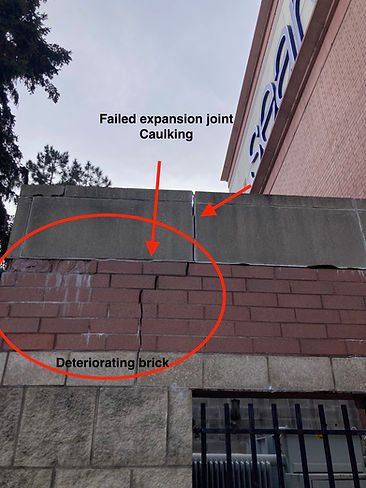
Straight Lines Caulking LLC
PROFESSIONAL COMMERCIAL CAULKING
What are expansion joints?
Expansion joints are engineered gaps or separations built into buildings, sidewalks, and other structures to allow for controlled movement.
What is the purpose of expansion joints in commercial buildings?
Commercial buildings have expansion joints to manage the natural movement of structures and building materials caused by:
-Thermal expansion and contraction
-Wind and vibration
-Building settlement
-Long spans of material that require stress relief.
*In essence, expansion joints maintain a building's structural integrity and help prevent costly damage or safety issues by allowing controlled movement.


In both photos above, failed expansion joint caulking is allowing water to penetrate behind the face of the building, causing cracking and deterioration below.
What issues can arise from failed expansion joint caulking in commercial buildings?
Failed expansion joint caulking can pose a significant problem for commercial buildings, as it compromises the integrity and function of the expansion joints, leading to a range of issues such as:
1. Water intrusion
2. Increased risk of cracking and structural damage
3. Increased maintenance and repair costs
4. Reduced Energy Efficiency
5. Aesthetic & property values
6. Structural integrity over time
1. Water intrusion
Caulking seals the joint, keeping water, moisture, and debris from entering. When the caulking fails, water can seep into the structure, causing damage to building materials and leading to corrosion, mold growth, and even structural decay over time.
2. Increased risk of cracking and structural damage
Moisture infiltration, combined with fluctuating temperatures, can lead to cracks in the surrounding areas due to expansion during freezing.
3. Increased maintenance and repair costs
When failed caulking is left unchecked, repair costs can escalate, as the failure may lead to water damage or more severe issues such as structural shifting, rusting reinforcement, or even the need to replace entire sections of a building once significant deterioration has occurred.
4. Reduced Energy Efficiency
Expansion joints have insulating properties, helping maintain energy efficiency by preventing air leaks. If the caulking fails, air can escape or infiltrate, leading to higher heating and cooling costs.
5. Aesthetic and Property values
Failed caulking often leads to visual gaps and cracks that affect the aesthetic appeal of a building. For commercial properties, this could potentially impact tenant satisfaction, client impressions, and property value.
6. Structural integrity over time
Expansion joints are designed to protect the building from the natural movements caused by temperature shifts, settling, and wind loads. When the caulking fails, it weakens the joint’s ability to handle those forces, which can result in long-term structural issues.
Conclusion
When expansion joint caulking fails, it can lead to a cascade of problems for commercial buildings, ranging from water damage and structural degradation to higher maintenance costs and safety concerns. It’s critical to inspect and maintain expansion joints regularly to avoid these issues and ensure the building’s longevity and functionality.


In the photo above, you can see cracking and deterioration in the building’s block, highlighted in red. You’ll also notice that someone attempted to repair the damage by filling the cracks with caulking. However, as the photo shows, new cracks have formed around the original ones — a clear sign that the underlying issue was never addressed.
So, what’s the real cause? The three arrows in the image point to the actual source of the problem: failed vertical expansion joint caulking above the damaged area. This failed joint is allowing water to funnel directly down into the wall, causing ongoing deterioration. Until that joint is professionally cut out and re-caulked, any attempts to seal the cracks below will be ineffective — and the damage will only continue to worsen.
Failed window perimeter caulking can lead to many of the same issues as failed expansion joints. Below are a few additional concerns that failed window perimeter and expansion joints can create for your property:
1. Pest infestation
2. Indoor air quality issues
3. Impact on sound insulation
1. Pest infestation
Gaps left by failed caulking provide an entry point for insects, rodents, and other pests. These pests can cause further damage or create health hazards within the building, adding to the overall maintenance burden.
2. Indoor air quality issues
If water infiltrates through failed caulking, it can contribute to poor indoor air quality. Damp, musty environments foster mold and mildew, which can trigger:
-
Health problems (allergies, asthma, respiratory issues)
-
Unpleasant odors inside the building.
3. Impact on sound insulation
Caulking also helps with soundproofing, especially in noisy urban environments. When the caulking fails, sound can seep in more easily through the gaps, leading to higher noise levels inside the building, which could be particularly disruptive in commercial office buildings and hotels.